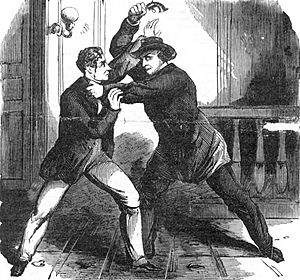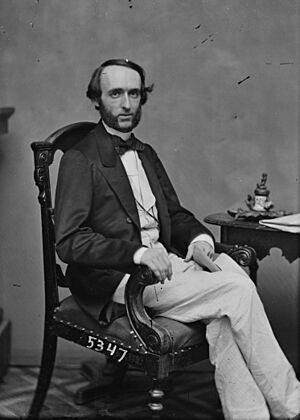Frederick W. Seward facts for kids
Quick facts for kids
Frederick W. Seward
|
|
|---|---|
 |
|
| 6th and 11th United States Assistant Secretary of State | |
| In office March 16, 1877 – October 31, 1879 |
|
| President | Rutherford B. Hayes |
| Preceded by | John Cadwalader |
| Succeeded by | John Hay |
| In office March 6, 1861 – March 4, 1869 |
|
| President | Abraham Lincoln Andrew Johnson |
| Preceded by | William H. Trescot |
| Succeeded by | Bancroft Davis |
| Member of the New York State Assembly from New York Co., 7th District | |
| In office January 1, 1875 – December 31, 1875 |
|
| Preceded by | Alfred Wagstaff, Jr. |
| Succeeded by | Isaac I. Hayes |
| Personal details | |
| Born |
Frederick William Seward
July 8, 1830 Auburn, New York, U.S. |
| Died | April 25, 1915 (aged 84) Montrose, New York, U.S. |
| Resting place | Fort Hill Cemetery Auburn, New York, U.S. |
| Political party | Republican |
| Spouse |
Anna Wharton
(m. 1854) |
| Relations |
|
| Parents | Frances Adeline Seward William H. Seward |
| Alma mater | Union College |
| Profession | Lawyer, writer, editor, politician |
| Signature | |
Frederick William Seward (born July 8, 1830 – died April 25, 1915) was an American politician. He was a member of the Republican Party. He served twice as the Assistant Secretary of State.
Frederick was the son of U.S. Secretary of State William H. Seward. He worked as Assistant Secretary from 1861 to 1869. During this time, his father was the Secretary under Presidents Abraham Lincoln and Andrew Johnson. He served again from 1877 to 1879 under President Rutherford B. Hayes.
Contents
Early Life and Family
Frederick Seward was born in Auburn, New York, on July 8, 1830. His mother was Frances Adeline Seward and his father was William H. Seward. Shortly after Frederick's birth, his father became a New York State Senator. His father later became the 12th governor of New York, a U.S. Senator, and the 24th U.S. Secretary of State.
Frederick had two older brothers, Augustus Henry Seward and General William H. Seward Jr.. He also had a younger sister named Fanny Seward. His grandfathers were Judge Elijah Miller and Judge Samuel S. Seward. Samuel Seward was also a doctor and a member of the New York State Assembly.
From 1839 to 1840, Frederick attended the Pearl Street Academy in Albany, New York. This was while his father was Governor of New York. He graduated from Union College in 1849. He then studied law and became a lawyer in 1851.
A Career in Government
After college, Frederick worked as a secretary for his father from 1849 to 1857. He also worked as an editor for the Albany Evening Journal newspaper from 1851 to 1861.
Protecting President Lincoln
On February 21, 1861, Frederick Seward arrived in Philadelphia. He carried an important letter from his father for President-elect Lincoln. The letter had information about a plot against Lincoln. This information came from detectives in Baltimore, Maryland.
Lincoln was traveling by train to Washington for his inauguration. He planned to stop in Baltimore. However, many people in Baltimore supported the idea of states leaving the Union. The detectives found out that some people were planning to harm Lincoln during his stop.
The warning Frederick brought helped Lincoln decide to pass through Baltimore secretly at night. This was instead of stopping publicly. Another person, Allan Pinkerton, also warned Lincoln. But Frederick's information confirmed the danger.
Working During the Civil War
When his father became Secretary of State in 1861, Frederick became the Assistant Secretary of State. He was in charge of services for Americans living abroad. He served in this role under Presidents Lincoln and Andrew Johnson until 1869.
He helped with important talks that led to the Burlingame Treaty. This agreement set rules for how the United States and China would work together. It helped China accept international laws.
A Dangerous Night
On April 14, 1865, Frederick was hurt during an attack on his father. This happened on the same night President Lincoln was murdered. Lewis Powell, who was part of a group with John Wilkes Booth, tried to kill William Seward. Secretary Seward was recovering at home from a carriage accident.
This attack was part of a bigger plan to cause confusion in the government. The plan was to also kill Vice President Andrew Johnson and President Lincoln that same evening.
Powell was later brought to justice for his actions.
Later Life and Writings
On April 17, 1868, Frederick Seward spoke as a witness in the trial of President Andrew Johnson. This was during Johnson's impeachment trial.
Frederick's father passed away on October 10, 1872. Frederick became a member of the New York State Assembly in 1875. He ran for Secretary of State of New York later that year but did not win. He served again as Assistant Secretary of State from 1877 until 1879. He left this job because he was ill.
Seward also edited and published his father's life story and letters. This book was called Life and Letters of William H. Seward. After 1881, he mostly worked as a lawyer and spent time lecturing and writing.
Personal Life
On November 9, 1854, Frederick married Anna Margaret Wharton. She was from Albany, New York. They later lived in a house he built in Montrose-on-the-Hudson. This home was near Peekskill. Their property had almost a mile of land along the Hudson River.
Frederick Seward died at his home in Montrose on April 25, 1915. He was 84 years old. He was buried with his family in Fort Hill Cemetery in Auburn, New York.
A year after he died, in 1916, his book was published. It was called Reminiscences of a War-Time Statesman and Diplomat, 1830-1915. This book was about the Civil War and politics. Also in 1916, his wife sold their home in Montrose.



